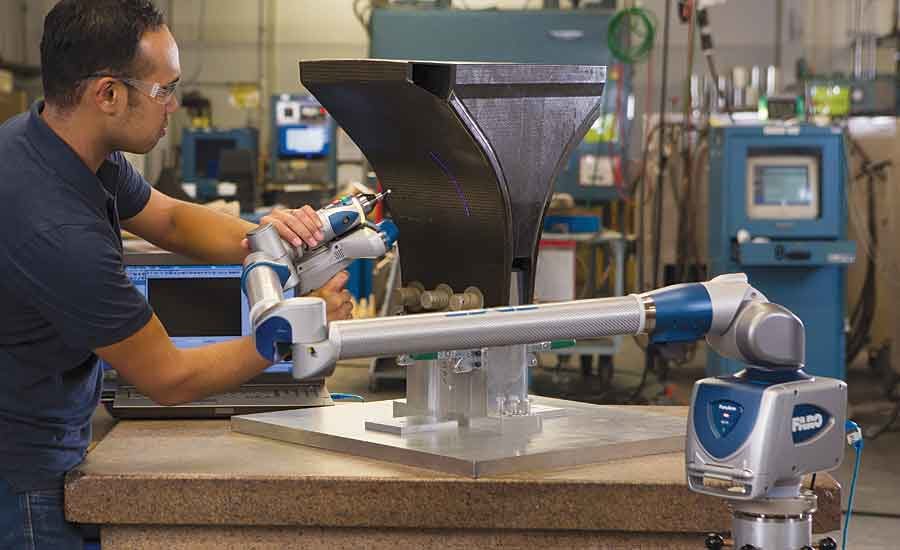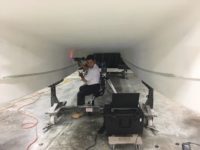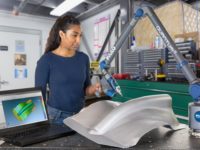ARO’s Laser Line Probe HD is a non-contact 3D Laser Scanning attachment for the FaroArm. When combined with the FARO Edge Arm the system is known as the FARO Edge ScanArm HD. Since it’s release in September of 2015, the ScanArm HD (referred to as the Laser Line Probe HD as a stand-alone device) has disrupted the 3D scanning world with it’s use of state-of-the-art blue laser technology and it’s ability to scan faster and more accurately across challenging materials. This article will dives explores how this new technology is taking 3D to the next level. The ScanArm HD is ideal for product development, inspection and quality control, and offers capabilities such as point-cloud comparison with CAD, rapid prototyping, reverse engineering, and 3-D modeling of free-form surfaces.
When combined with the FaroArm, the Laser Line Probe combines all of the advantages of your hard probing system with the capabilities of 3-D laser scanning to provide rapid point cloud collection with high-definition resolution and precise accuracy—all in a compact, easy-to-use, and fully-integrated system.
The ScanArm HD combines the power of a blue laser, state-of-the art camera and optics to maximize:
- Scanning speed, delivering the highest possible productivity
- Accuracy, providing the ability to meet tight-tolerances.
- High-Definition (HD) resolution that captures clear, noise-free data with intricate details
- Scanning of challenging surfaces including dark and reflective materials
Key Design Parameters
In designing the ScanArm HD, FARO’s engineers recognized that a number of factors must all work in harmony to optimize performance. It can be tempting for a buyer to look at one or two specs on a spec sheet and arrive at an incorrect conclusion as to which product is best. Key elements in a scanner design must all come together to produce the final result. If one element is sub-optimal, it cancels the benefits of other design elements. Consider a car that may have a powerful engine, but poor driving performance because of a bad steering or transmission design. For a laser line probe product, the key design parameters impacting performance are:
- Laser type – typically blue laser or red laser
- Optics – The lenses used on the camera
- Frame rate – the speed at which the camera can capture a scanned area, measured in points per second and driven by the chip set that the camera uses
- Laser line width – also called beam width or scan stripe width
Laser Type
Today’s scanners employ one of two laser types: blue laser or red laser. Earlier scanner models, including FARO’s prior Laser Line Probes used red laser technology. The new ScanArm HD, however, leverages an optically-superior blue laser technology.
While blue laser technology is more costly than red laser technology, a blue laser has the laws of physics on its side because it has a shorter wavelength than a red laser. Shorter wavelengths provide higher optical resolution; therefore the blue laser delivers improved scanning results and a 50% reduction in speckle noise.
Benefits: The ScanArm HD’s blue laser offers 50% better optical resolution than a red laser scanner. This difference is most noticeable when scanning optically challenging objects with dark and/or reflective surfaces. With red laser technology, it is sometimes necessary to use a special spray on the scanned object to make the surface less reflective, or multiple target placements. The blue laser’s optical qualities reduces the need to spray parts. This removes an unnecessary step from your measurement process and saves you valuable time.
Optics
The FARO ScanArm HD boasts superior, large-diameter, custom optics. While lens size is only one consideration in optical design (other considerations include coating, and the arrangement of the lenses), it certainly impacts scan accuracy. A larger lens is able to:
- Collect more data
- Deliver better accuracy by collecting more light – sharper and brighter images
- Offer a bigger “sweet spot” in terms of data collection, overcoming the blur or optical aberrations that smaller optics may create at the edges of a scanned area
- Support a wider laser line width that scans a larger area, providing faster, more productive scanning
Benefits:The ScanArm HD’s large optics provide higher accuracy in scanning and greater productivity in comparison to most scanners on the market. The blue laser and purposefully-designed optics combine to deliver faster scans with higher resolution and better contrast, outperforming competing solutions.
Frame Rate
The ScanArm HD’s camera uses the most advanced chipset available to deliver the fastest possible frame rate of 280 frames per second (fps). Frame rate (also referred to as refresh rate) refers to the number of times per second that the camera gathers new data on the part being scanned. Competing products use older, less expensive chipsets that only support frame rates of 100 fps or slower.
Benefits:Higher frame rate produces faster scanning with superior resolution, delivering greater productivity. A frame rate of 280 fps delivers 2.8 times the scanning speed of a frame rate set at 100 fps. A higher frame rate also delivers superior scan resolution, because sampling a part with more points provides better reconstruction of the original part from the scanned image. Scanners with low (100 fps) frame rates are prone to producing gaps or blurs in measurement data if they were to move at the same travel speed as the ScanArm HD across a part.
Laser Line Width
The ScanArm HD features laser line width of 150mm. Laser line width (also called beam width or stripe width) is the end-to-end distance of the laser line or stripe produced by the scanner’s laser. The wider the laser line width, the wider the area that can be scanned in a single pass. Additionally, the ScanArm HD features a solid, blue laser beam. Some other scanners do not use a solid beam, but instead use a rolling shutter or “flying dot” arrangement whereby the laser oscillates via moving mirrors to produce the illusion of a solid laser line. The flying dot arrangement has inherent flaws, including vibration from the motion of the mirrors. Vibration causes blurs on the scan, potentially causing errors in accuracy and impacting productivity by forcing the user to repeat scans over the same areas.
Flying dot technology also constrains scan speed and consistency.
Benefits:A wider beam, coupled with larger optics means that more data can be gathered in each scan frame. Coupled with the ScanArm HD’s state-of-the-art frame rate, these two benefits can be multiplied to compare scanning productivity. For example, the ScanArm HD’s frame rate is 2.8 times higher than most competing products. If the ScanArm HD’s beam width is 1.7 times that of a competing product, the resulting scan speed differential is 2.8 X 1.76 = 4.8 times better than the competing product. The ScanArm HD would scan nearly five times the surface area versus a competing product in the same time. In addition, the solid stripe (versus flying dot) results in a more even distribution of the scanned data points, and therefore, greater resolution and quality.
The differences between a solid laser beam and a flying dot arrangement are illustrated in the following figures. A flying dot scanner is unable to produce uniform data or point spacing in the same way that a solid beam scanner such as the ScanArm HD does. With a flying dot scanner, the faster the movement, the greater the sparseness of data between data points.
The comparison between flying dot and solid beam becomes more apparent in the data below. With the solid beam, more data points are gathered with consistent spacing. The resulting meshed file is a more exact representation of the original item.
Speed, Accuracy and High Definition Data in the Same System
With the FARO Edge ScanArm HD system all of the design parameters and features are integrated seamlessly to deliver the ability to scan faster than ever before, easily scan across challenging surfaces without any special sprays, and collect clean, noise-free data in high-definition resolution with precise and consistent accuracy.
The ScanArm HD eliminates the need for compromises between accuracy and speed. Manufacturer product specifications sheets are sometimes confusing and can be misleading. There are no established industry standards for laser line scanning, so product comparisons can be difficult. A manufacturer may tout the number of points per laser stripe, but the under-sampled distribution of flying point data yields poor accuracy compared to laser line technology. Additionally, the resolution of red laser data is significantly degraded when compared to blue laser data. If the frame rate is not fast, scanning rates must be dramatically decreased to maintain desired accuracies. In summary: Quality of data points must be regarded with the same significance as the quantity of data.
FARO
250 Technology Park
Lake Mary, FL 32746









